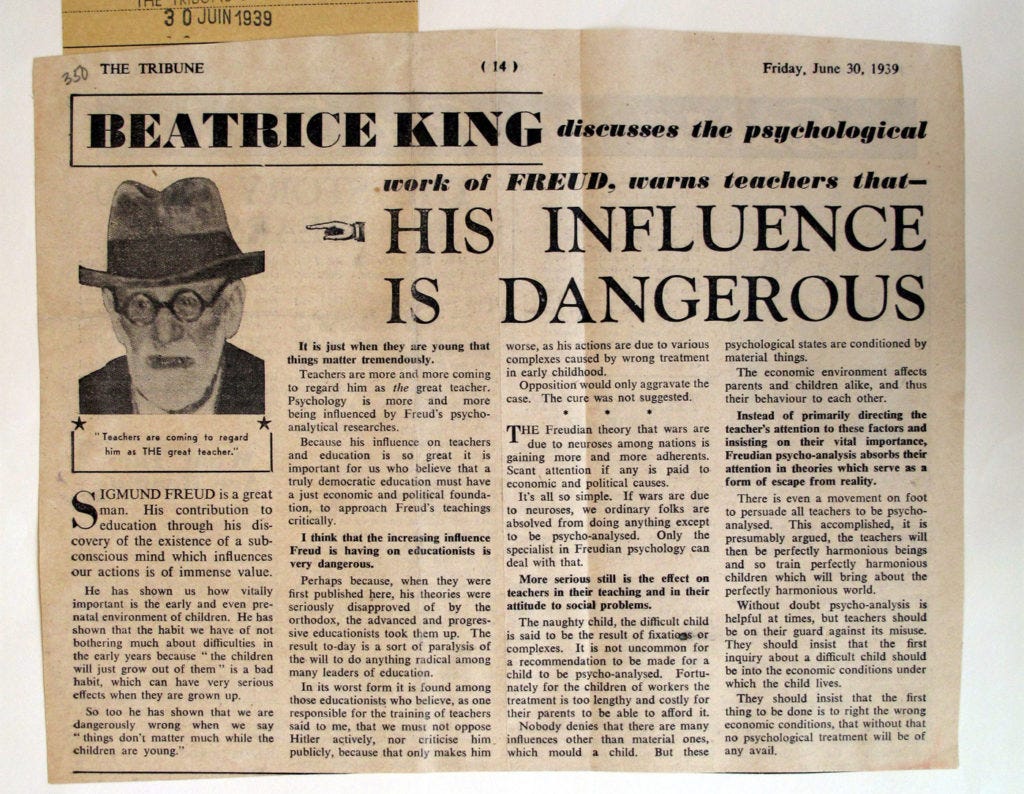A Deep Reading of Why Freud Was Wrong: Sin, Science and Psychoanalysis, by Richard Webster
(Part One · Part Two · Part Three · Part Four · Part Five)
Concretizing the Unconscious
Freud never ceased to be driven by his own huge and messianic ambitions. If any scientific or medical doctrine seemed to promise a way of realizing these ambitions, his habit was to fall passionately and uncritically in love with that doctrine to the exclusion of all skepticism and all intellectual moderation (Webster, p. 226).
When Webster addresses the idea of the unconscious that is foundational to Freudian psychology, he makes a convincing case that the idea of human beings acting unconsciously has been around hundreds, if not thousands, of years, via Shakespeare all the way back to Plato. (He doesn’t cite the Bible; maybe he doesn’t want to give it any kind of positive PR.)
If there was nothing new about positing the idea of human beings acting unconsciously, or of aspects to our experience being unconscious, Freud took it further by positing an unconscious as a state, or an entity, out of which things emerged, and into which things could be suppressed.
It is this addition, Webster argues, that separates the Freudian Unconscious from the mere observation of behaviors, and makes of it more of an empirical, pseudo-scientific framework; one that is also potentially metaphysical.
What Freud was really talking about, even if he never acknowledged it (and I will get to this) was the body—since the only feasible location for “an unconscious” is the body. Instead, he helped to create an abstract principle, quality, or quantity, called “the Unconscious.”
What Webster argues is that this was a response, or reaction, to a growing bias in society towards reductionism. Just as the gothic novel and romanticism was a reaction and corrective to the triumph of enlightenment rationalism, so psychoanalytical theory, Webster argues, was a response to the increasing hegemony of scientific rationalism, in Freud’s own time.
The problem, for Webster, was that Freudianity also incorporated atavistic beliefs about the demonic aspects of human nature “which had been implicitly repudiated by Protestant rationalism” (p. 245). Because of this, it had profound psychological resonance. Webster’s perspective is that Freud never actually acknowledged this fact; that he didn’t even realize he was doing it:
[Freud] genuinely believed he was making a new scientific discovery. It was partly in order to preserve this precious illusion that he did almost exactly what he had done in the case of his concept of catharsis: he reintroduced an ancient intuitive view only after he had first both medicalized it and technicalized it (p. 245).
Automatic Repression Vs. Autonomous Repression
When Freud created the idea of a mental entity to host our hidden thoughts, memories and impulses—an autonomous region of the mind “with its own wishful impulses, its own mode of expression, and its peculiar mental mechanisms which are not in force elsewhere” (ibid.)—this led to the idea that certain aspects of our experience become unconscious because they’re being actively repressed.
Freud then posited that the act of repression has pathological consequences, that it causes illness, and that such illness can only be cured by making the repressed elements conscious. “Freud further believed that, in psychoanalysis, he had discovered the one and only method by which this previously unknown region could be observed” (p. 245-6).
Freud’s idea of repression was as an active but largely unconscious function of the psyche that had a biological basis, centering on sexuality. Hence the Freudian tenet that human sexuality has to be biologically repressed, in order for civilization to exist and continue, etc. etc.
Webster’s counterargument is that sexual desire is not unconscious, and that nor is sexual engagement, that it is rather a preeminently conscious form of behavior. He then makes the claim that the use of sexual imagination and fantasy is “a precondition of full orgasmic potency” (p. 247).
This last seems highly questionable to me, but I won’t get into a critique of Webster just yet; the idea that we might fantasize about sex before we act on our desire, anyway, is not hard to understand. It’s also complimentary with Webster’s point that, a lot of the time, the suppression of our sexual desire is done consciously.
For Freud to insist that it’s unconscious, or even that it’s purely biological (because biological also implies unconsciousness, or at the very least, non-volitional), seems less than accurate, and may have been a self-serving claim, to boot.
The monolithic idea of the unconscious as a kind of submerged continent that we have to dive down into the waters to get to ignores the fact that what separates conscious from unconscious behavior is a moving line, that it is different from individual to individual, as well as from moment to moment.
There is an element of choice involved, of volition. Just as we choose to forget, ignore, or suppress some desires, fantasies, or memories, so we can also potentially bring them back into awareness.
It is true that Freud, in his original theory, did see repression of trauma as an “act of will,” by which an individual drives thoughts from his mind. But “he did not believe that repression remained under conscious control” hence, “a person who has supposedly suffered a pathogenic trauma could not generally recall it without psychoanalytical assistance” (p. 247-8).





